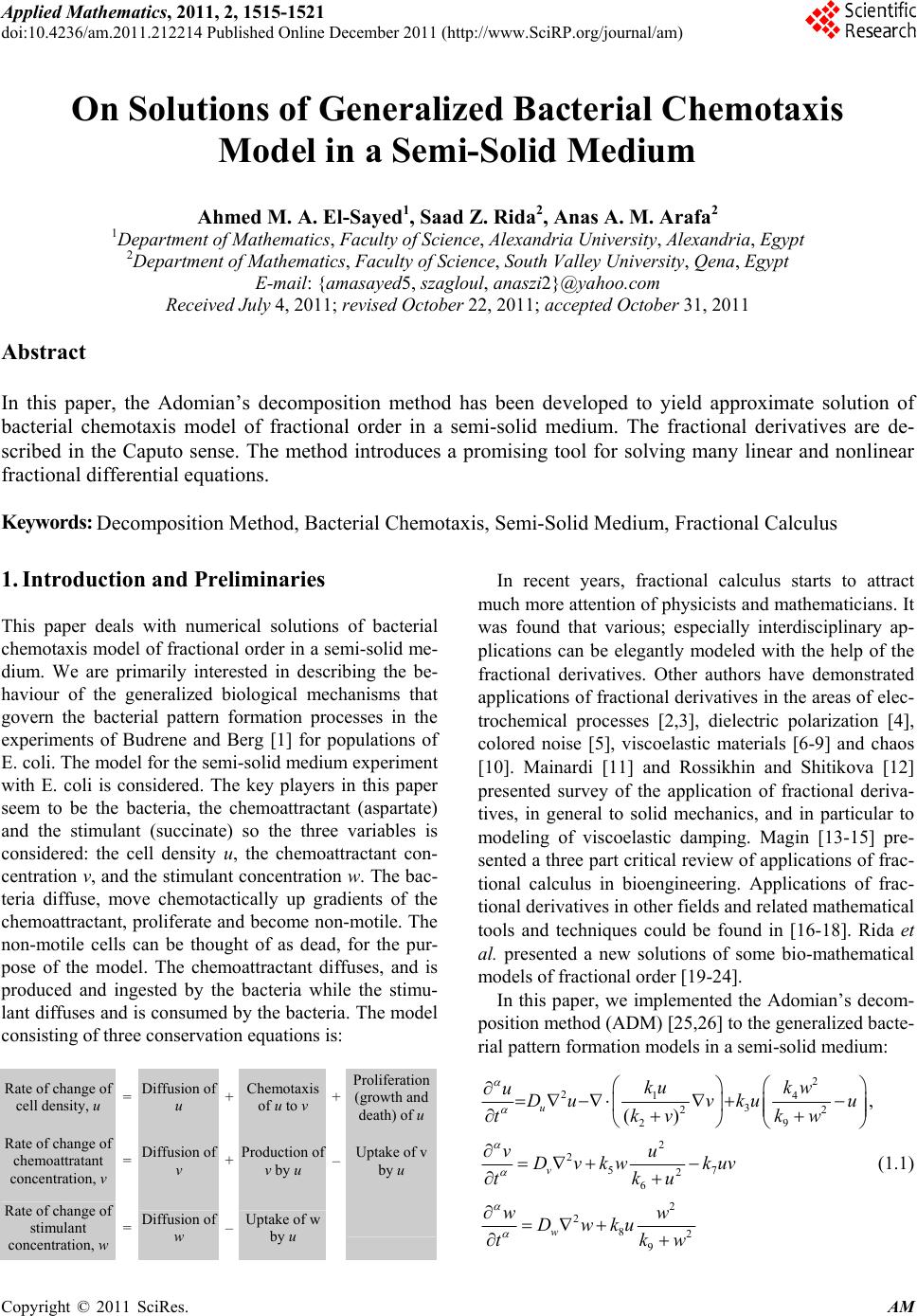 Applied Mathematics, 2011, 2, 1515-1521 doi:10.4236/am.2011.212214 Published Online December 2011 (http://www.SciRP.org/journal/am) Copyright © 2011 SciRes. AM On Solutions of Generalized Bacterial Chemotaxis Model in a Semi-Solid Medium Ahmed M. A. El-Sayed1, Saad Z. Rida2, Anas A. M. Arafa2 1Department of Mathematics, Faculty of Science, Alexandria University, Alexandria, Egypt 2Department of Mathematics, Faculty of Science, South Valley University, Qena, Egypt E-mail: {amasayed5, szagloul, anaszi2}@yahoo.com Received July 4, 2011; revised October 22, 2011; accepted October 31, 2011 Abstract In this paper, the Adomian’s decomposition method has been developed to yield approximate solution of bacterial chemotaxis model of fractional order in a semi-solid medium. The fractional derivatives are de- scribed in the Caputo sense. The method introduces a promising tool for solving many linear and nonlinear fractional differential equations. Keywords: Decomposition Method, Bacterial Chemotaxis, Semi-Solid Medium, Fractional Calculus 1. Introduction and Preliminaries This paper deals with numerical solutions of bacterial chemotaxis model of fractional order in a semi-solid me- dium. We are primarily interested in describing the be- haviour of the generalized biological mechanisms that govern the bacterial pattern formation processes in the experiments of Budrene and Berg [1] for populations of E. coli. The model for the semi-solid medium experiment with E. coli is considered. The key players in this paper seem to be the bacteria, the chemoattractant (aspartate) and the stimulant (succinate) so the three variables is considered: the cell density u, the chemoattractant con- centration v, and the stimulant con centration w. The bac- teria diffuse, move chemotactically up gradients of the chemoattractant, proliferate and become non -motile. The non-motile cells can be thought of as dead, for the pur- pose of the model. The chemoattractant diffuses, and is produced and ingested by the bacteria while the stimu- lant diffuses and is consumed by the bacteria. The model consisting of three conservation equations is: Rate of change of cell density, u = Diffusion of u +Chemotaxis of u to v + Proliferation (growth and death) of u Rate of change of chemoattratant concentration, v = Diffusion of v +Production of v by u – Uptake of v by u Rate of change of stimulant concentration, w = Diffusion of w –Uptake of w by u In recent years, fractional calculus starts to attract much more attention of physicists and mathematicians. It was found that various; especially interdisciplinary ap- plications can be elegantly modeled with the help of the fractional derivatives. Other authors have demonstrated applications of fractional derivatives in the areas of elec- trochemical processes [2,3], dielectric polarization [4], colored noise [5], viscoelastic materials [6-9] and chaos [10]. Mainardi [11] and Rossikhin and Shitikova [12] presented survey of the application of fractional deriva- tives, in general to solid mechanics, and in particular to modeling of viscoelastic damping. Magin [13-15] pre- sented a three part critical review of applications of frac- tional calculus in bioengineering. Applications of frac- tional derivatives in other fields and related mathematical tools and techniques could be found in [16-18]. Rida et al. presented a new solutions of some bio-mathematical models of fractional order [19-24]. In this paper, we implemented the Adomian’s decom- position method (ADM) [25,26] to the generalized bacte- rial pattern formation models in a semi-solid medium: 2 214 3 22 29 2 257 2 6 2 282 9 , () u v w kuk w uDuvku u tkvkw vu Dvkw kuv tku ww Dwku tkw (1.1) 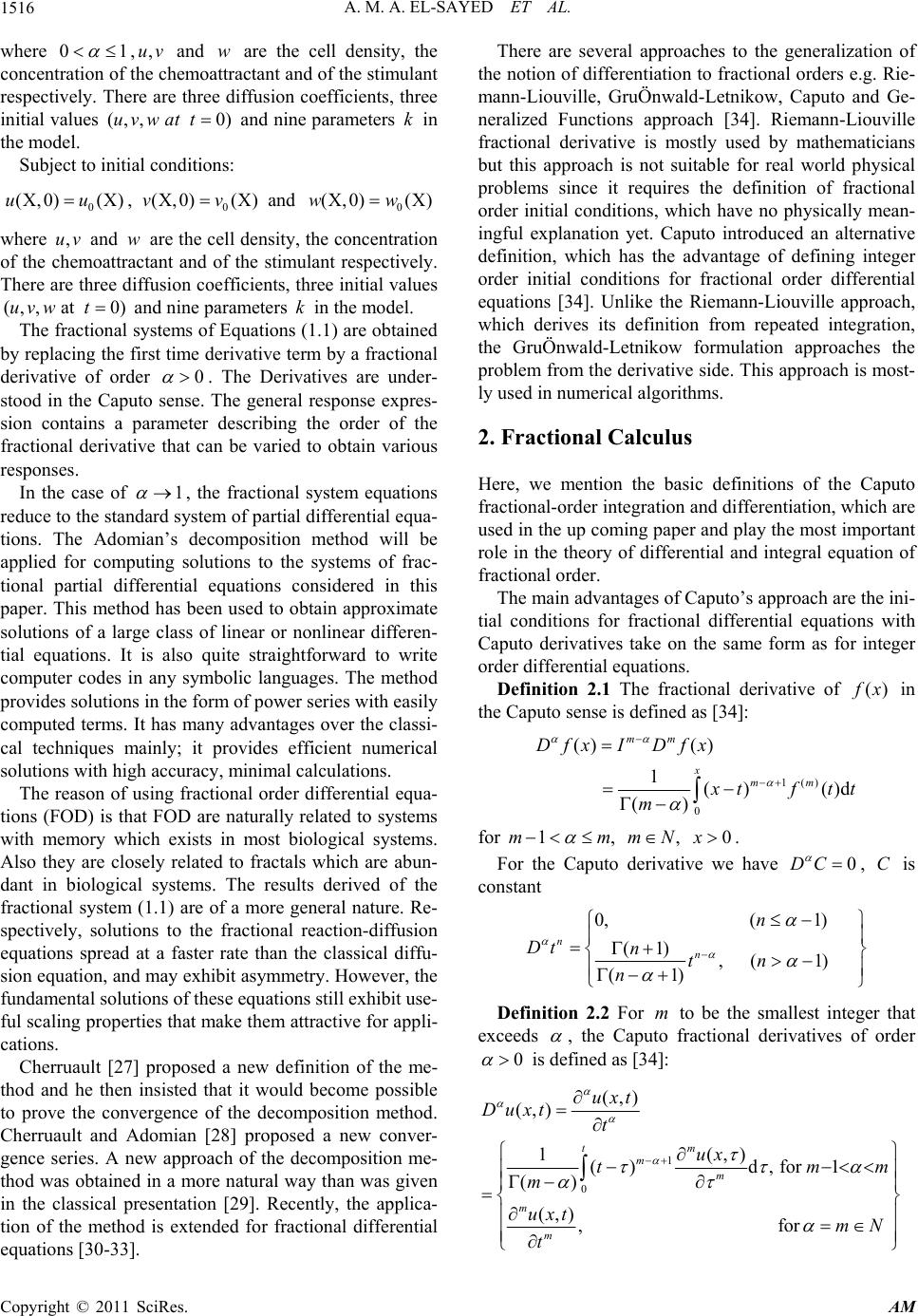 A. M. A. EL-SAYED ET AL. 1516 where 01 , concentration respectively. There alues (,uv del. ,uv of the chem are ,wa and are the cell density, the actant and of the stimulant three diffusion coefficients, three initial v and nine parameters the mo Subject to initial conditions: and where and are the cell density, the concentratio oattractant and of stems of Ein the first time derivative term by a fractional de w oattr 0)t tk in n 0 (,0) ()uu, 0 (,0) ()vv 0 (,0) ()ww ,uv hem w al sy of the cthe stimulant respectively. There are three diffusion co efficients, three initial values (,, at0)uvw t and nine parameters k in the model. The fractionquations (1.1) are obtaed by replacing rivative of order 0 . The Derivatives are under- stood in the Caputo sense. The g sion contains a parameter desche order of the al tiv eneral response expres- ribing t fractionderivae that can be varied to obtain various responses. In the case of 1 , the fractional system equations ndard system of partiadifferential equreduce to the stal a- tio ntial des in any symbolic languages. The method pr in the , the fu tion of the method is extended for fractional differential equations [30-33]. n of differentiation to fractional orders e.g. Rie- m ions for fractional order differential eq me form as for integer rder differential equations. derivative of ns. The Adomian’s decomposition method will be applied for computing solutions to the systems of frac- tional partial differeequations considered in this paper. This method has been used to obtain approximate solutions of a large class of linear or nonlinear differen- tial equations. It is also quite straightforward to write computer co ovides solutions form of power series with easily computed terms. It has many advantages over the classi- cal techniques mainly; it provides efficient numerical solutions with high accuracy, minimal calculations. The reason of using fractional order differential equa- tions (FOD) is that FOD are naturally related to systems with memory which exists in most biological systems. Also they are closely related to fractals which are abun- dant in biological systems. The results derived of the fractional system (1.1) are of a more general nature. Re- spectively, solutions to the fractional reaction-diffusion equations spread at a faster rate than the classical diffu- sion equation, and may exhibit asymmetry. However ndament al so l ut i on s o f t h ese equations still exhibit use- ful scaling p roperties that make them attractive for appli- cations. Cherruault [27] proposed a new definition of the me- thod and he then insisted that it would become possible to prove the convergence of the decomposition method. Cherruault and Adomian [28] proposed a new conver- gence series. A new approach of the decomposition me- thod was obtained in a more natural way than was given in the classical presentation [29]. Recently, the applica- There are several approaches to the generalization of the notio ann-Liouville, GruÖnwald-Letnikow, Caputo and Ge- neralized Functions approach [34]. Riemann-Liouville fractional derivative is mostly used by mathematicians but this approach is not suitable for real world physical problems since it requires the definition of fractional order initial conditions, which have no physically mean- ingful explanation yet. Caputo introduced an alternative definition, which has the advantage of defining integer order initial condit uations [34]. Unlike the Riemann-Liouville approach, which derives its definition from repeated integration, the GruÖnwald-Letnikow formulation approaches the problem from the derivative side. This approach is most- ly used in numerical algorithms. 2. Fractional Calculus Here, we mention the basic definitions of the Caputo fractional-order integration and differentiation, which are used in the up coming paper and play the most important role in the theory of differential and integral equation of fractional order. The main advantages of Caputo’s approach are the ini- tial conditions for fractional differential equations with Caputo derivatives take on the sa oDefinition 2.1 The fractional() x in e Caputo sense is defined as [34]: th 1() 0 () () 1() ()d () mm x mm DfxIDfx tftt m for 1,mm ,mN 0x. For the Caputo derivative we have 0DC , C is constant ( 1) 1) n n 0, (1) ,( (1) n n Dt nt n Definition 2.2 For to be the smallest integer that exceeds m , the Caputo fractional derivatives of order 0 is defined as [34]: 1 0 (,) (,) 1( ux uxt t ,) ()d,for 1 () (,) ,for tm m m m m D ux tm m m uxt mN t t Copyright © 2011 SciRes. AM 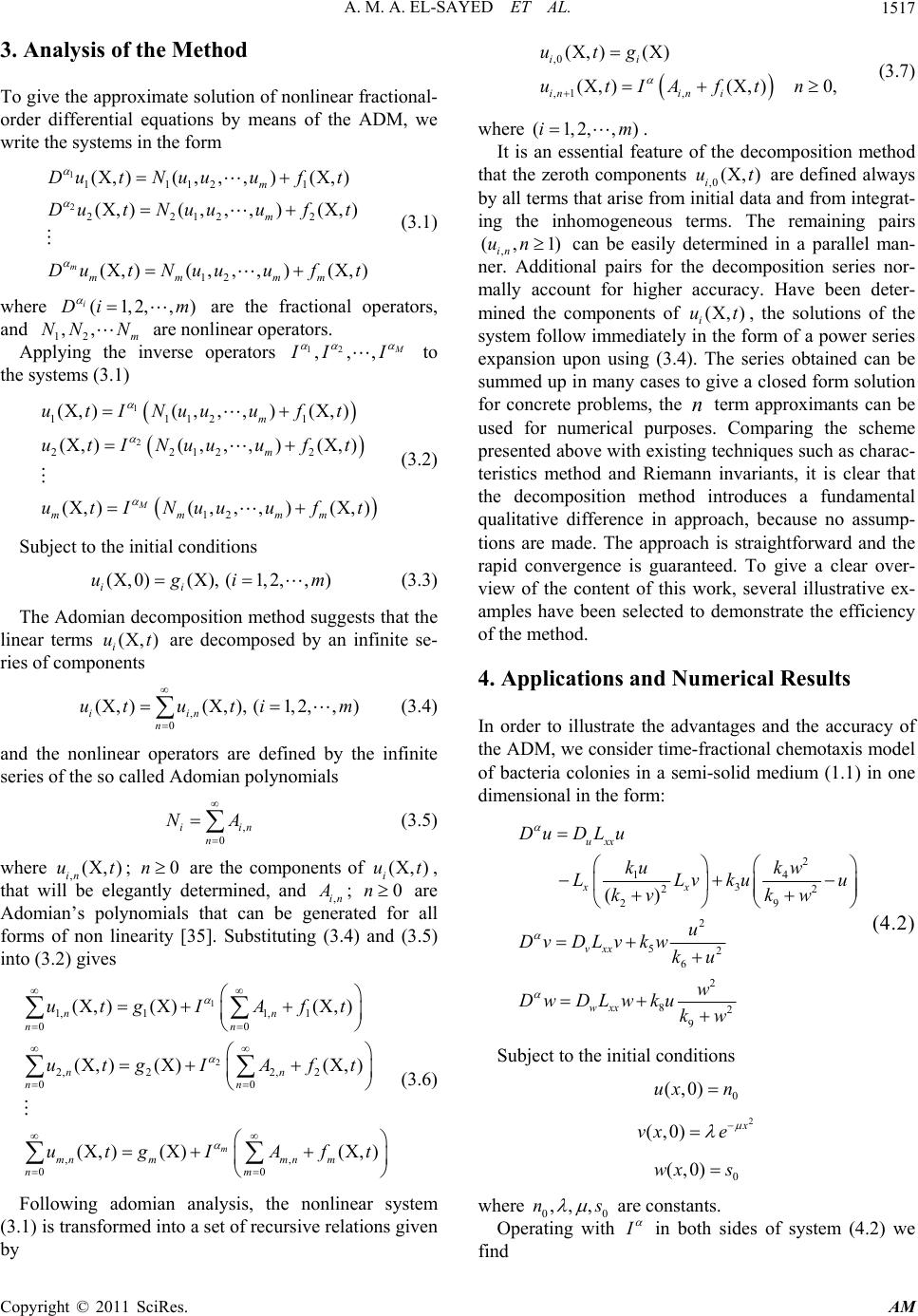 A. M. A. EL-SAYED ET AL.1517 3. To givolution of nonlinear fractional- order differential equations by means of the ADM, we write the systems in the form (3.1) e fractional operators, nd nonlinear operators. Analysis of the Method e the approximate s 1 2 1112 1 2212 2 12 (,)(, ,,)(,) (,)(, ,,)(,) (,)(, ,,)(,) m m m mm mm Dut Nuuuft Dut Nuuuft Dut Nuuuft where (1,2,,) i Di m are th a12 Applying the inverse operators 12 ,,, ,, m NN N are III to the systems (3.1) 1 (3.2) (3.3) d suggests that are decomposed by an infinite se- ries of com and the nonlinear operators are defined by the infinite series of the so called Adomian polynomials n w 2 11121 22122 12 (,)(, ,,)(,) (,)(, ,,)(,) (,)(, ,,)(,) M m m mmmm utINuuuft utINuuu ft utINuuuft Subject to the initial conditions )(),(1,2, ,) i gi m (,0 i u The Adomian decomposition metho the linear terms (,ut) i ponents , 0 (,)(,),(1,2, ,) iin n utu tim (3.4) , 0 ii n NA (3.5) here ,(,) in ut; 0n are the components of (,) i ut , that will be elegantly determined, and ,in ; 0n are Adomian’s polynomials that can be generated forms of non linearity [35]. Substituting (3.4) and (3.5) into (3.2) gives ed into a set of recursive relations given by for all 1 1,11, 1 00 (,) ()(,) nn nn utg IAft 2 2, 2 00 (, ) () n nn ut g I 2,2 (,) n Aft (3.6) ,, 00 (, ) ()(,) m mn mmn m nm ut g IAft Following adomian analysis, the nonlinear system (3.1) is transform ,0 ,1 , (,) () (,)(,) 0, ii inin i utg utIAftn (3.7) where (1,2,,)im . It is an essential feature of the decomposition m that the zeroth components are defined always by all terms that arise from integrat- ing the inhomogeneous termaining pairs can be easily determined in a parallel man- omponents of , the solutions of the me of a power series expansion upon using (3.4). es obtain any cases to closed form solution problemthe approximants can be us qualitative work, s ethod ,0 (,) i ut initial data and from s. The rem (,) i ut diately in the form The seri give a n term ,in r. Additional pairs for the decomposition series nor- mally account for higher accuracy. Have been deter- min (, 1)un ne ed the c system follow im summed up in m crete ed can be for cons, ed for numerical purposes. Comparing the scheme presented above with existing techniques such as charac- teristics method and Riemann invariants, it is clear that the decomposition method introduces a fundamental difference in approach, because no assump- tions are made. The approach is straightforward and the rapid convergence is guaranteed. To give a clear over- view of the content of this everal illustrative ex- amples have been selected to demonstrate the efficiency of the method. 4. Applications and Numerical Results In order to illustrate the advantages and the accuracy of the ADM, we consider time-fractional chemotaxis model of bacteria colonies in a semi-solid medium (1.1) in one dimensional in the form: 2 14 3 22 29 () uxx xx Du DLu kuk w LLvkuu kv kw 2 2 u w 52 6 vx x Dv DLv kw ku 82 9 wx x Dw DLw ku kw (4.2) Subject to the initial conditions ux 0 (,0)n 2 (,0) vx e 0 (,0)wx s where 00 ,,,ns Operating with are constants. in both sides of system (4.2) we find Copyright © 2011 SciRes. AM 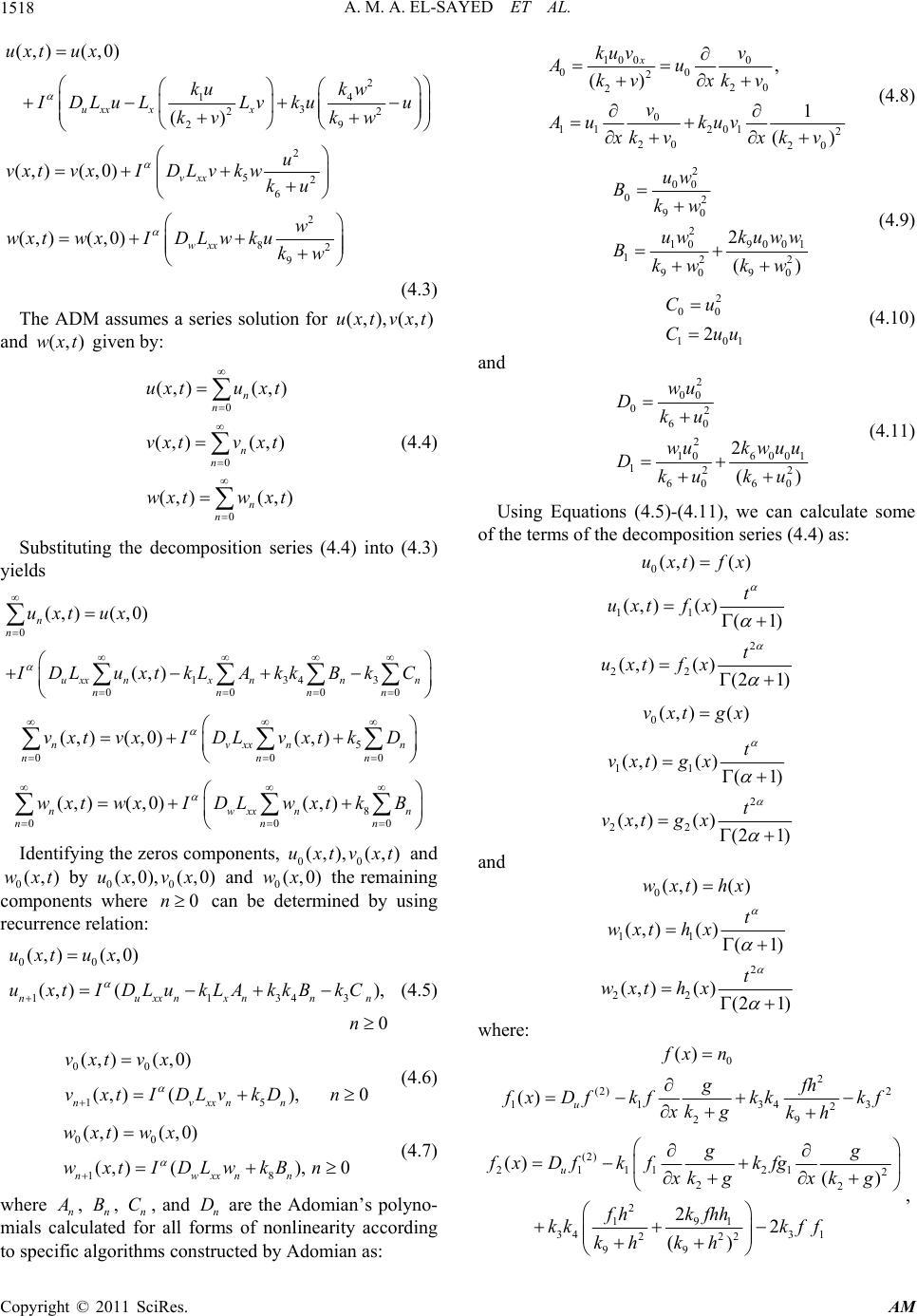 A. M. A. EL-SAYED ET AL. 1518 2 14 3 2 29 2 52 6 2 82 9 (,) (,0) () (,) (,0) (,) (,0) uxx xx vxx wxx uxt ux kuk w 2 DL uLLvkuu kv kw u vxtvxIDL vkw ku w wxtwxIDL wku kw (4.3) The ADM assumes a series solution for and given by: Substituting the decomposition series (4.4) into (4.3) yields 0 n (,),(,)uxtvxt (,)wxt 0 0 (,)( ) ( (,) (,) n n n n uxtuxt vx wxtw xt 0 ,) (,) n n tvxt (4.4) , 0 1343 000 (,) (,0) (,) n n uxxnxnnn nnn uxt ux DLu xtkLAkkBkC 0n 0 n n Identifying the zeros components, and by and can be det recurrence relation: (4.6 (4.7) where 5 (,) (,0)(,) nvxxn vxtvxI DLvxtkD 00nn n 8 00 (,) (,0)(,) nwxxn nn wxtwxI DLwxt kB 00 (,), (,)uxtvxt (x 0(,)wxt component 00 (,0), (,0)ux vx s where 0n0 w,0) the remaining ermined by using 00 (,) (,0) 0 uxt ux u n 11 343 (,) (), nuxxnxnnn x tIDLukLAkkBkC (4.5) 00 15 (,) (,0) (,) (),0 nvxxnn vxt vx vxtIDLvkD n ) 00 18 (,) (,0) (,)(), 0 nwxxnn wxt wx wxtIDLwkBn n , n B, als calculated for all fo n C 100 0 00 220 2 0 11201 2 0 ) v Au kuv v 20 2 , () 1 ( x kuv v Au xk v kv xkvx k (4.8) 2 0 B00 2 90 2 10 9001 122 90 90 2 () uw kw uw kuww Bkw kw (4.9) 1 u (4.10) and 2 00 10 2 Cu Cu 2 00 02 60 2 106 001 122 6060 ()ku ku Using Equations (4.5)-(4.11), we can calculate 2 wu Dku wukwuu D some of the terms of the decomposition series (4.4) as: (4.11) 0(,) ()uxtfx 11 (,)() (1) t uxt fx 2 22 (,)() (2 1) t uxtfx 0(,) ()vxt gx 11 (,)() (1) t vxt gx 2 t 22 (,)() (2 1) vxtgx and 0(,) ()wxt hx 11 (,)() (1) t wxt hx 2 22 (,)() (2 1) wxt hx where: t 0 () xn 2 (2) 2 1134 2 29 () u gfh 3 xDfkfkkkf xk gkh (2) 211121 2 22 291 1 343 1 222 99 () () 22 () u gg fxDfkfkfg xkgx kg kfhh fh kkk f f khkh , , and are the Adomian’s polyno- mi s of nonlinearity according to specific algorithms constructed by Adomian as: n D rm Copyright © 2011 SciRes. AM 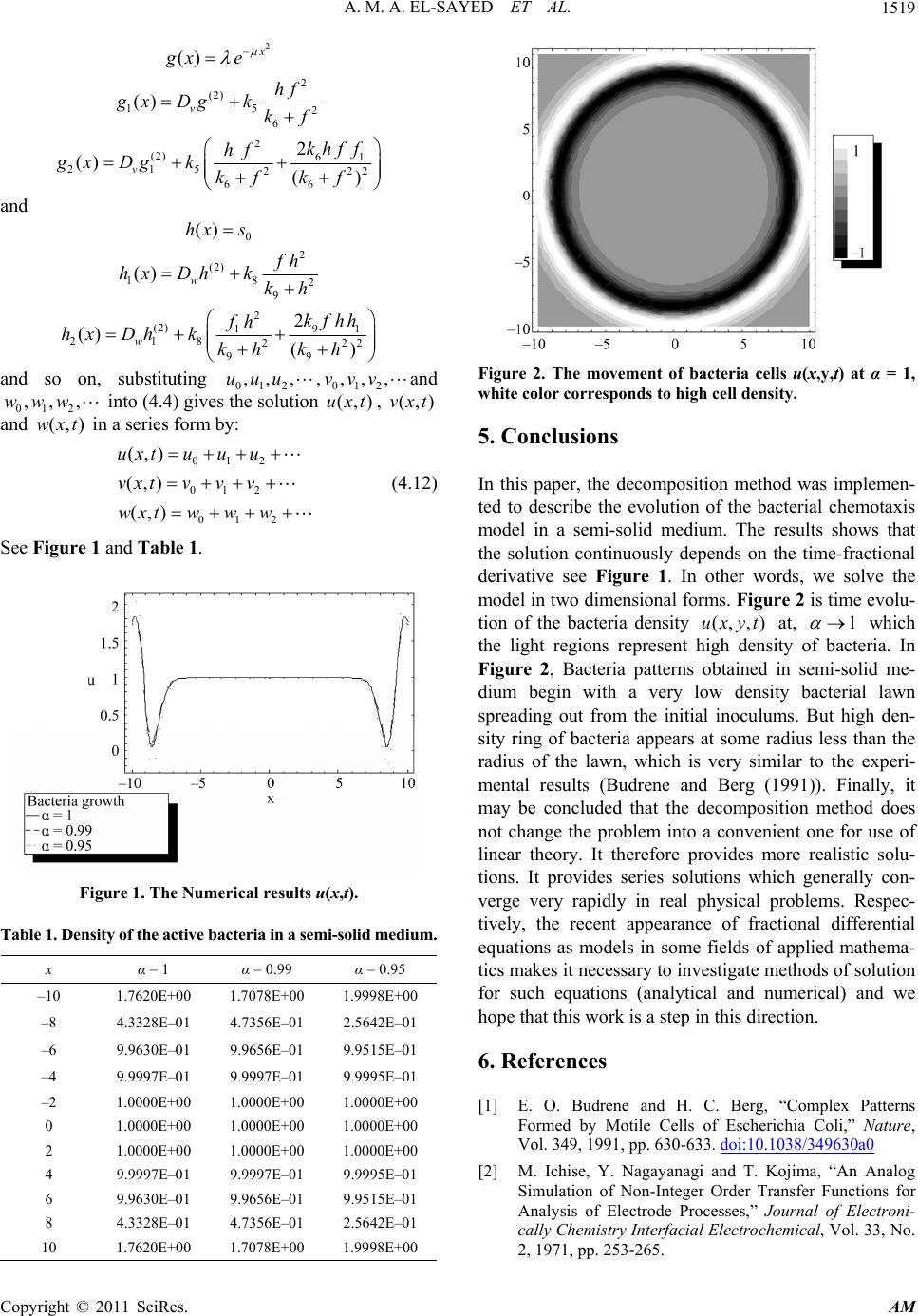 A. M. A. EL-SAYED ET AL.1519 2 () gx e 2 (2) 15 2 6 () v hf gx Dgkkf 2 (2) 61 1 215 22 66 2 () () v khff hf gxDgk kf kf 2 and 0 ()hx s 2 (2) 18 2 9 () w h hx Dhkkh 2 (2) 91 1 218 22 99 2 () () w kfhh fh hxDhk kh kh 2 and so on, substituting 012 ,,,uuu,012 ,,,vvv (,)uxt, (,vx and into (4.4) gives the solution in a series form (4.12) See Figure 1 and Table 1. 012 ,,,www and (,)wxt ) t by: 012 012 012 (,) (,) (,) uxtuu u vxtvv v wxtww w Figure 1. The Numericau ity of the active bacteria in a sem. α = 1 α l results (x,t). Table 1. Densi-solid medium x = 0.99 α = 0.95 –10 1.7620E+00 1.7078E+00 1.9998E+00 –8 4.3328E–01 4.7356E–01 –6 9.9630E–01 9.9656E–01 9.9515E–01 9.9997E–01 9.9995E–01 –2 1.0000E+00 1.0000E+00 1.0000E+00 0 1.0000E+00 1.0000E+00 1.0000E+00 2 1.0000E+00 1.0000E+00 1.0000E+00 4 9.9997E–01 9.9997E–01 9.9995E–01 6 9.9630E–01 9.9656E–01 9.9515E–01 8 4.3328E–01 4.7356E–01 2.5642E–01 10 1.7620E+00 1.7078E+00 1.9998E+00 2.5642E–01 –4 9.9997E–01 Figure 2. The movement of bacteria cells u(x,y,t)at α = 1, 5. Coclusion In thaper, tosit wa- ted tscribeion eriais mode a seediuultat the solution codep timl derivative see In s, we mode two d for 2 i tion ofthe bac white color corresponds to high cell density. ns is phe decompion methods implemen o de the evolutof the bactl chemotax l inmi-solid mm. The ress shows th ntinuously ends on thee-fractiona Figure 1. other worde solve th l inimensionalms. Figure s time evolu- teria density(,,) at, uxyt1 of bacteria. which the light regions n Figure 2, Bacns obtaine seme- diumegin w lo ban spreading out itia. B- sity ring of bacteria appears at some radius less than the radius of the lawn, which is very similar to the experi- mental results (Budrene and Berg (1991)). Finally, it may be concluded that the decomposition method does not change the problem into a convenient one for use of linear theory. It therefore provides more realistic solu- tions. It provides series solutions which generally con- verge very rapidly in real physical problems. Respec- tively, the recent appearance of fractional differential equations as models in some fields of applied mathema- tics makes it necessary to investigate methods of solution for such equations (analytical and numerical) and we hope that this work is a step in this direction. and H. C. Berg, “Complex Patterns tile Cells of Escherichia Coli,” Nature, Vol. 349, 1991, pp. 630-633. doi:10.1038/349630a0 represent high density I teria patter ith a veryd in w densityi-solid m cterial law bfrom the inl inoculumsut high den 6. References [1] E. O. Budrene Formed by Mo 2, 1971, pp. 253-265. [2] M. Ichise, Y. Nagayanagi and T. Kojima, “An Analog Simulation of Non-Integer Order Transfer Functions for Analysis of Electrode Processes,” Journal of Electroni- cally Chemistry Interfacial Electrochemical, Vol. 33, No. Copyright © 2011 SciRes. AM 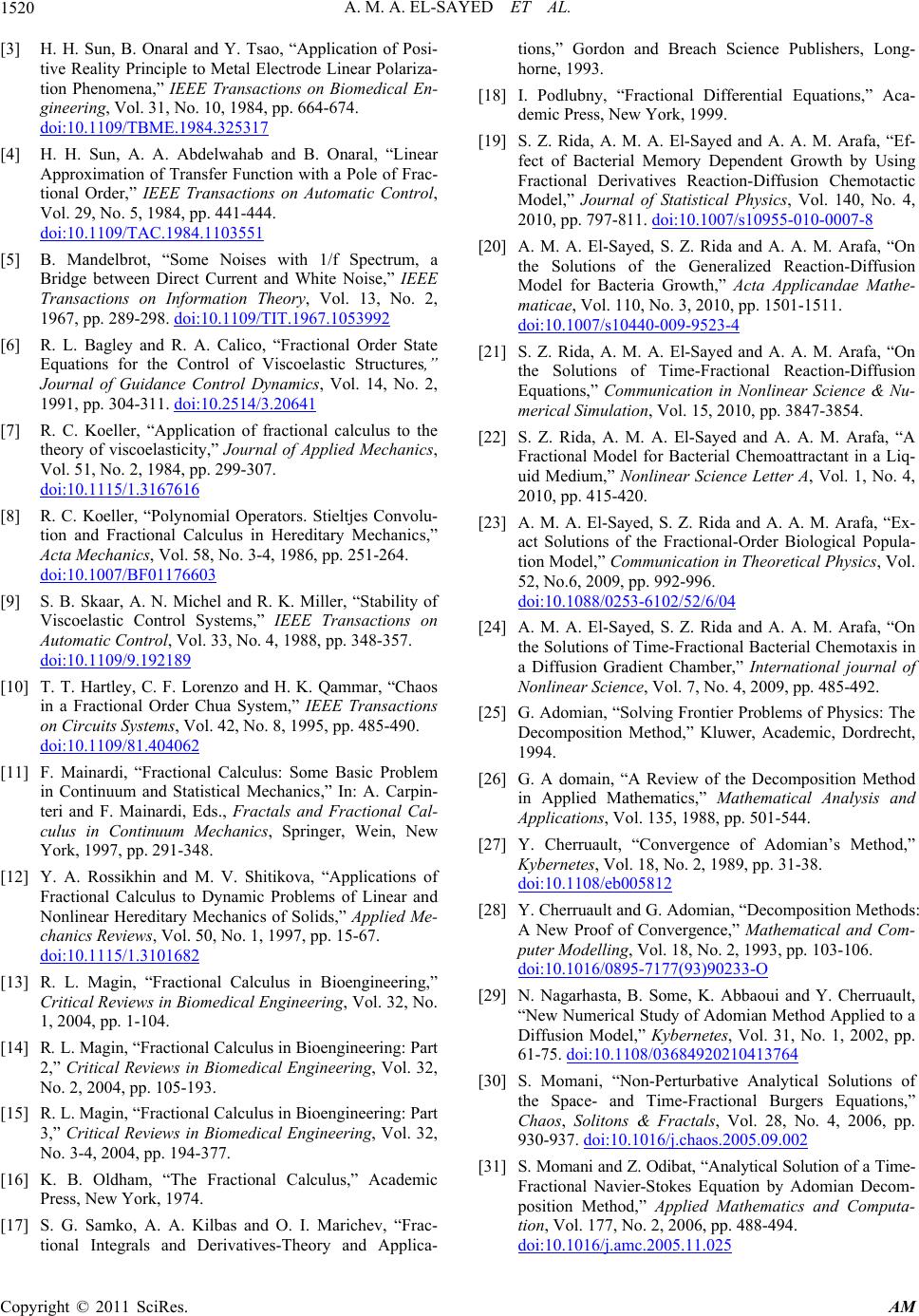 A. M. A. EL-SAYED ET AL. 1520 [3] H. H. Sun, B. Onaral and Y. Tsao, “Application of Posi- tive Reality Principle to Metal Electrode Linear Polariza- tion Phenomena,” IEEE Transactions on Biomedical En- gineering, Vol. 31, No. 10, 1984, pp. 664-674. doi:10.1109/TBME.1984.325317 [4] H. H. Sun, A. A. Abdelwahab and B. Onaral, “Linear Approximation of Transfer Function with a Pole of Frac- tional Order,” IEEE Transactions on Automatic Control, Vol. 29, No. 5, 1984, pp. 441-444. doi:10.1109/TAC.1984.1103551 [5] B. Mandelbrot, “Some Noises with 1/f Spectrum, a Bridge between Direct Current and White Noise,” IEEE Transactions on Information Theory, Vol. 13, No. 2, 1967, pp. 289-298. doi:10.1109/TIT.1967.1053992 [6] R. L. Bagley and R. A. Calico, “Fractional Order State Equations for the Control of Viscoelastic Structures,” Journal of Guidance Control Dynamics, Vol. 14, No. 2, 1991, pp. 304-311. doi:10.2514/3.20641 [7] R. C. Koeller, “Application of fractional calculus to the theory of viscoelasticity,” Journal of Applied Mechanics, Vol. 51, No. 2, 1984, pp. 299-307. doi:10.1115/1.3167616 [8] R. C. Koeller, “Poly tion and Fractnomial Operators. Stieltjes Convolu- ional Calculus in Hereditary Mechanics, Acta Mechanics, Vol. 58, No. 3-4, 1986, pp. 251-264. ” doi:10.1007/BF01176603 [9] S. B. Skaar, A. N. Michel and R. K. Miller, “Stability of Viscoelastic Control Systems,” IEEE Transactions on Automatic Control, Vol. 33, No. 4, 1988, pp. 348-357. doi:10.1109/9.192189 [10] T. T. Hartley, C. F. Lorenzo and H. K. Qammar, “Chaos in a Fractional Order Chua System,” IEEE Transactions on Circuits Systems, Vol. 42, No. 8, 1995, pp. 485-490. doi:10.1109/81.404062 [11] F. Mainardi, “Fractional Calculus: Some Basic Problem in Continuum and Statistical Mechanics,” In: A. Carpin- teri and F. Mainardi, Eds., Fractals and Fractio culus in Continuum Mechanics, nal Cal- Springer, Wein, New Solids,” Applied Me- . 15-67. York, 1997, pp. 291-348. [12] Y. A. Rossikhin and M. V. Shitikova, “Applications of Fractional Calculus to Dynamic Problems of Linear and Nonlinear Hereditary Mechanics of chanics Reviews, Vol. 50, No. 1, 1997, pp doi:10.1115/1.3101682 [13] R. L. Magin, “Fractional Calculus in Bioengineering,” Critical Reviews in Biomedical Engineering , Vol. 32, No. 1, 2004, pp. 1-104. [14] R. L. Magin, “Fractional Calculus in Bioengineering: Part 2,” Critical Reviews in Biomedical Engineering , Vol. 32, No. 2, 2004, pp. 105-193. [15] R. L. Magin, “Fractional Calculus in Bioengineering: Part alculus,” Academic - ory Dependent Growth by Using 3,” Critical Reviews in Biomedical Engineering , Vol. 32, No. 3-4, 2004, pp. 194-377. [16] K. B. Oldham, “The Fractional C Press, New York, 1974. [17] S. G. Samko, A. A. Kilbas and O. I. Marichev, “Frac- tional Integrals and Derivatives-Theory and Applica- tions,” Gordon and Breach Science Publishers, Long horne, 1993. [18] I. Podlubny, “Fractional Differential Equations,” Aca- demic Press, New York, 1999. [19] S. Z. Rida, A. M. A. El-Sayed and A. A. M. Arafa, “Ef- fect of Bacterial Mem Fractional Derivatives Reaction-Diffusion Chemotactic Model,” Journal of Statistical Physics, Vol. 140, No. 4, 2010, pp. 797-811. doi:10.1007/s10955-010-0007-8 [20] A. M. A. El-Sayed, S. Z. Rida and A. A. M. Arafa, “On the Solutions of the Generalized Reaction-Diffusion Model for Bacteria Growth,” Acta Applicandae Mathe- maticae, Vol. 110, No. 3, 2010, pp. 1501-1511. doi:10.1007/s10440-009-9523-4 [21] S. Z. Rida, A. M. A. El-Sayed and A. A. M. Arafa, “On a, “A erial Chemoattractant in a Liq- S. Z. Rida and A. A. M. Arafa, “Ex- 6. the Solutions of Time-Fractional Reaction-Diffusion Equations,” Communication in Nonlinear Science & Nu- merical Simulation, Vol. 15, 2010, pp. 3847-3854. [22] S. Z. Rida, A. M. A. El-Sayed and A. A. M. Araf Fractional Model for Bact uid Medium,” Nonlinear Science Letter A, Vol. 1, No. 4, 2010, pp. 415-420. [23] A. M. A. El-Sayed, act Solutions of the Fractional-Order Biological Popula- tion Model,” Communication in Theoretical Physics, Vol. 52, No.6, 2009, pp. 992-99 doi:10.1088/0253-6102/52/6/04 [24] A. M. A. El-Sayed, S. Z. Rida and A. A. M. Arafa, “On the Solutions of Time-Fractional Bacterial Chemotaxis in “A Review of the Decomposition Method a Diffusion Gradient Chamber,” International journal of Nonlinear Science, Vol. 7, No. 4, 2009, pp. 485-492. [25] G. Adomian, “Solving Frontier Problems of Physics: The Decomposition Method,” Kluwer, Academic, Dordrecht, 1994. [26] G. A domain, in Applied Mathematics,” Mathematical Analysis and Applications, Vol. 135, 1988, pp. 501-544. [27] Y. Cherruault, “Convergence of Adomian’s Method,” Kybernetes, Vol. 18, No. 2, 1989, pp. 31-38. doi:10.1108/eb005812 [28] Y. Cherruault and G. Adomian, “Decomposition Methods: A New Proof of Convergence,” Mathematical and Com- puter Modelling, Vol. 18, No. 2, 1993, pp. 103-106. doi:10.1016/0895-7177(93)90233-O [29] N. Nagarhasta, B. Some, K. Abbaoui and Y. Cherruault, “New Numerical Study of Adomian Method App Diffusion Model,” Kybernetes, Vlied to a ol. 31, No. 1, 2002, pp. 61-75. doi:10.1108/03684920210413764 [30] S. Momani, “Non-Perturbative Analytical Solutions of the Space- and Time-Fractional Burgers Equations,” Chaos, Solitons & Fractals, Vol. 28, No. 4, 2006, pp. 930-937. doi:10.1016/j.chaos.2005.09.002 [31] S. Momani and Z. Odibat, “Analy tical Solution of a Time- Fractional Navier-Stokes Equation by Adomian Decom- position Method,” Applied Mathematics and Computa- tion, Vol. 177, No. 2, 2006, pp. 488-494. doi:10.1016/j.amc.2005.11.025 Copyright © 2011 SciRes. AM 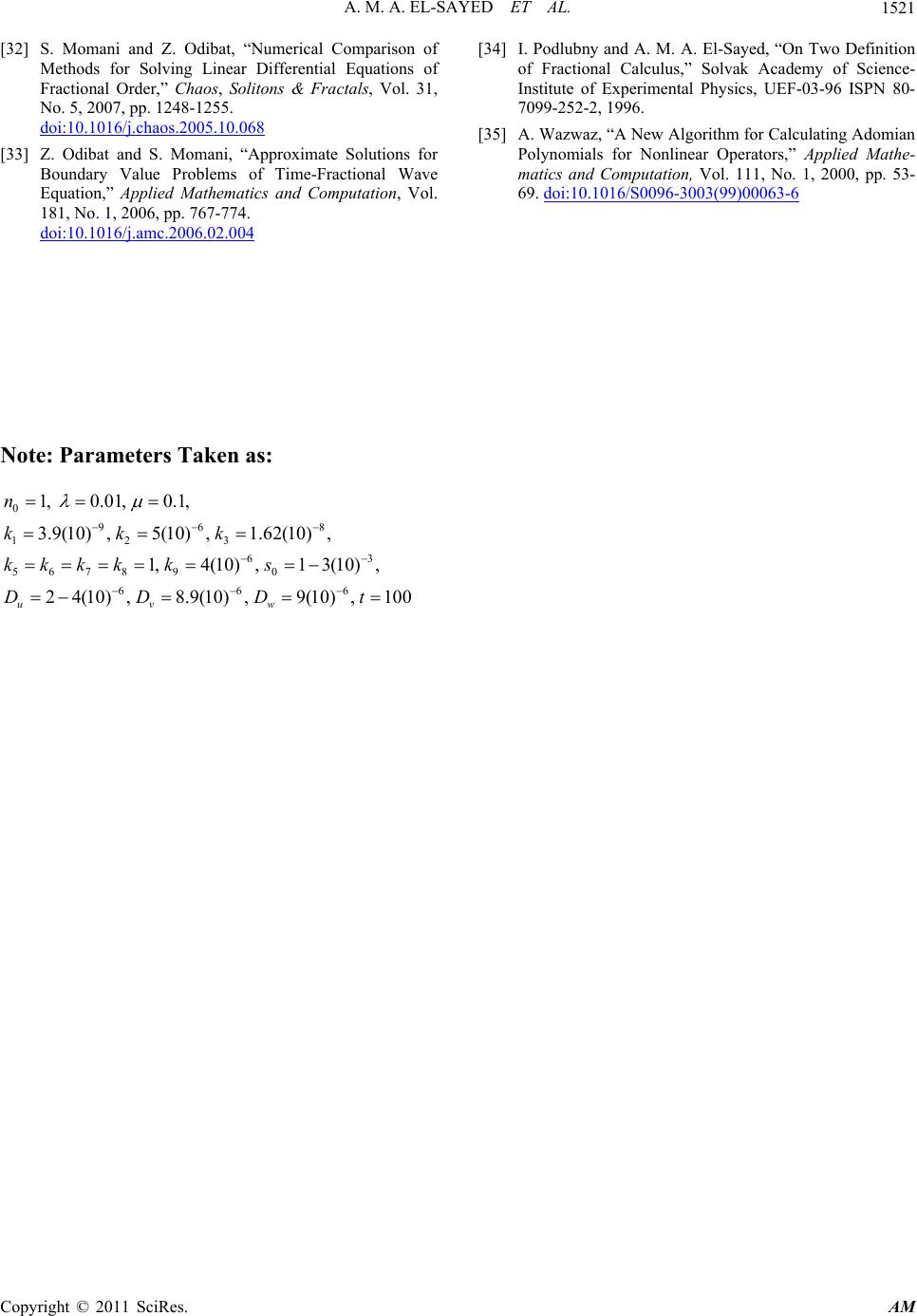 A. M. A. EL-SAYED ET AL. Copyright © 2011 SciRes. AM 1521 Differential Equations of ns & Fractals, Vol. 31, [32] S. Momani and Z. Odibat, “Numerical Comparison of Methods for Solving Linear Fractional Order,” Chaos, Solito [34] I. Podlubny and A. M. A. El-Sayed, “On Two Definition of Fractional Calculus,” Solvak Academy of Science- pplied Mathe- 11, No. 1, 2000, pp. 53- Institute of Experimental Physics, UEF-03-96 ISPN 80- 7099-252-2, 1996. [35] A. Wazwaz, “A New Algorithm for Calculating Adomian Polynomials for Nonlinear Operators,” A matics and Computation, Vol. 1 No. 5, 2007, pp. 1248-1255. doi:10.1016/j.chaos.2005.10.068 [33] Z. Odibat and S. Momani, “Approximate Solutions for Boundary Value Problems of Time-Fractional Wave Equation,” Applied Mathematics and Computation, Vol. 181, No. 1, 2006, pp. 767-774. doi:10.1016/j.amc.2006.02.004 69. doi:10.1016/S0096-3003(99)00063-6 Note: Parameters Taken as: 0 968 123 1,0.01, 0.1, 3.9(10) ,5(10) ,1.62(10),kk 63 5678 90 666 1,4(10),1 3(10) , 24(10) ,8.9(10),9(10),100 kkkk ks DDt uvw n k D
|